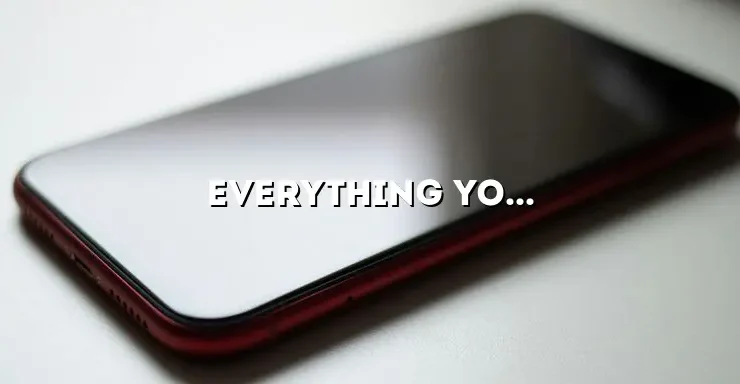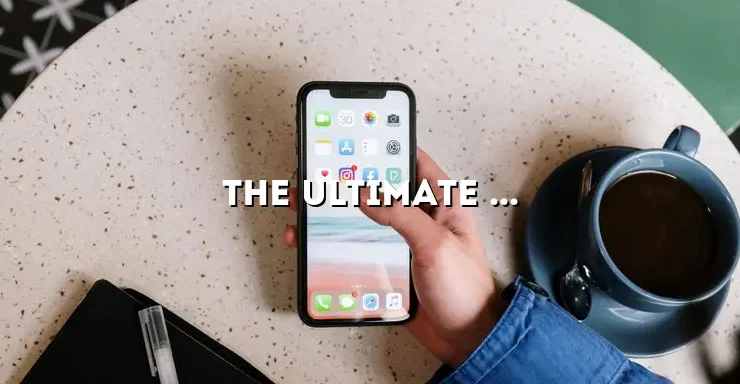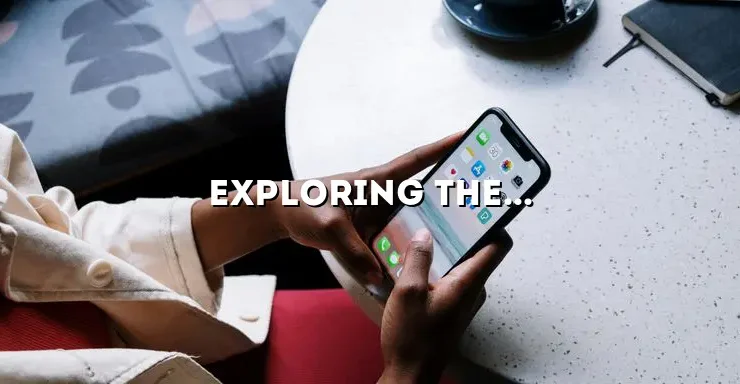
Since its introduction in 2007, the iPhone has revolutionized the way we communicate, work, and entertain ourselves. With each new generation, Apple has consistently pushed the boundaries of innovation, introducing groundbreaking features and design enhancements. In this blog article, we will take a deep dive into the generaciones de iPhone, exploring the evolution of this iconic device and highlighting the key features and improvements that each generation has brought to the table. Whether you’re a long-time iPhone user or someone curious about the history of this iconic device, this comprehensive guide will provide you with an in-depth understanding of how the iPhone has evolved over the years.
The First Generation (2007)
The first-generation iPhone, introduced by Steve Jobs in 2007, was a game-changer in the mobile industry. It combined three devices into one: a revolutionary mobile phone, a widescreen iPod with touch controls, and a breakthrough internet communications device. With its sleek design and large multi-touch display, the iPhone set a new standard for smartphones.
Design and Operating System
The first-generation iPhone featured a unique and minimalistic design, with a 3.5-inch display and a single physical home button. It ran on the iOS operating system, which provided a user-friendly interface and seamless integration with other Apple services. The device also introduced the iconic App Store, which allowed users to download and install third-party applications.
Impact on the Smartphone Market
The introduction of the iPhone disrupted the smartphone market, challenging traditional players like Nokia and BlackBerry. Its intuitive user interface, combined with the ability to browse the web, send emails, and run various applications, made it a compelling choice for consumers. The App Store, in particular, revolutionized the way we interacted with our smartphones, opening up a world of possibilities for developers to create innovative and useful apps.
The iPhone 3G and 3GS (2008-2009)
Building on the success of the first-generation iPhone, Apple released the iPhone 3G and 3GS, introducing significant improvements and new features.
3G Connectivity and App Store
The iPhone 3G was the first iPhone to support 3G connectivity, providing faster data speeds for browsing the web and downloading content. This opened up new possibilities for users, allowing them to stream media, download apps, and stay connected on the go. The device also introduced the App Store, which quickly became a huge success, offering a wide range of applications for users to enhance their iPhone experience.
Improved Camera and Performance
The iPhone 3GS brought improvements to both the camera and performance. It featured a 3-megapixel camera with autofocus and video recording capabilities. This allowed users to capture higher-quality photos and videos, making the iPhone a popular choice for capturing memories. The device also introduced a faster processor and more RAM, resulting in smoother performance and better multitasking capabilities.
The iPhone 4 and 4S (2010-2011)
The iPhone 4, with its stunning design and high-resolution Retina display, marked another significant milestone in the evolution of the iPhone.
Design and Retina Display
The iPhone 4 introduced a sleek and modern design, with a stainless steel frame and glass panels on the front and back. It featured a 3.5-inch Retina display, which had a pixel density of 326 pixels per inch, making it the highest-resolution display at the time. This resulted in sharper text, more vibrant colors, and improved overall visual quality.
FaceTime and Siri
The iPhone 4 was the first iPhone to introduce FaceTime, Apple’s video calling technology. This allowed users to have face-to-face conversations with friends and family, no matter where they were. Additionally, the iPhone 4S introduced Siri, Apple’s virtual assistant, which revolutionized the way we interacted with our smartphones by enabling voice commands and natural language processing.
The iPhone 5, 5C, and 5S (2012-2013)
With the iPhone 5, Apple introduced a larger display, lighter body, and LTE connectivity, further enhancing the user experience. Additionally, the iPhone 5C and 5S brought new design options and improved features.
Larger Display and Lighter Body
The iPhone 5 featured a larger 4-inch display, providing more screen real estate for browsing the web, watching videos, and interacting with apps. Despite the larger display, Apple managed to make the iPhone 5 even lighter and thinner than its predecessor, making it more comfortable to hold and carry.
iPhone 5C: Colorful Design
The iPhone 5C introduced a vibrant and playful design, featuring a polycarbonate shell in various colors. It was aimed at a more budget-conscious market, offering similar specifications to the iPhone 5 but at a lower price point. The iPhone 5C allowed users to express their personality through their choice of color.
iPhone 5S: Touch ID and Enhanced Camera
The iPhone 5S introduced Touch ID, Apple’s fingerprint recognition technology, which allowed users to securely unlock their device and make purchases with a simple touch of their finger. It also featured an improved camera with larger pixels and a dual-LED flash, resulting in better low-light performance and more natural-looking photos.
The iPhone 6 and 6 Plus (2014)
The iPhone 6 and 6 Plus brought a significant design change, with larger screens and a slimmer profile, catering to the increasing demand for larger smartphones.
Bigger Screens and Slimmer Profile
The iPhone 6 featured a 4.7-inch display, while the iPhone 6 Plus boasted a larger 5.5-inch display. These larger screens provided a more immersive viewing experience for multimedia content and improved productivity for tasks such as email and web browsing. Despite the larger screens, Apple managed to make the iPhone 6 and 6 Plus even thinner, resulting in a sleek and elegant design.
Improved Cameras and Apple Pay
The iPhone 6 and 6 Plus introduced improved camera sensors, optical image stabilization, and faster autofocus, resulting in better image quality and enhanced video recording capabilities. Additionally, these devices introduced Apple Pay, a mobile payment system that allowed users to make secure payments using their iPhone, further integrating the iPhone into our daily lives.
The iPhone 7 and 7 Plus (2016)
The iPhone 7 and 7 Plus brought several significant changes, including a water-resistant design, the removal of the headphone jack, and an improved camera system for the Plus model.
Water-Resistant Design
The iPhone 7 and 7 Plus introduced a water and dust-resistant design, providing users with added peace of mind in everyday use. This allowed the devices to withstand accidental spills, splashes, and even immersion in water up to a certain depth for a limited time.
Removal of the Headphone Jack
One of the most controversial changes with the iPhone 7 was the removal of the traditional headphone jack. This decision paved the way for wireless audio solutions and encouraged the adoption of Bluetooth headphones and earphones. While initially met with mixed reactions, it pushed the industry towards a more wireless future.
Dual-Camera System (iPhone 7 Plus)
The iPhone 7 Plus introduced a dual-camera system, consisting of a wide-angle lens and a telephoto lens. This allowed users to capture photos with optical zoom and achieve a depth-of-field effect, commonly referred to as “Portrait Mode.” The enhanced camera capabilities of the iPhone 7 Plus offered users more versatility and professional-looking results.
The iPhone 8, 8 Plus, and X (2017)
The iPhone 8, 8 Plus, and X brought significant design changes and introduced new features that further elevated the iPhone experience.
Glass Back Design and Wireless Charging
The iPhone 8 and 8 Plus featured a glass back design, which not only gave them a modern and premium look but also enabled wireless charging. Users could now charge their iPhones by simply placing them on a compatible charging pad, eliminating the need for cables.
Improved Cameras (iPhone 8 Plus)
The iPhone 8 Plus continued the trend of the dual-camera system, further improving the image quality and introducing new features such as Portrait Lighting. This feature allowed users to apply different lighting effects to their portrait photos, giving them more control over the final result.
Edge-to-Edge Display and Face ID (iPhone X)
The iPhone X marked a significant design departure with its edge-to-edge display, which eliminated the home button and introduced Face ID, Apple’s facial recognition technology. Face ID allowed users to unlock their iPhone, authenticate app purchases, and even create animated emojis using their facial expressions.
Conclusion
In conclusion, the generaciones de iPhone have brought us a series of remarkable advancements, transforming the way we interact with technology. From the first-generation iPhone to the latest iPhone X, Applehas consistently pushed the boundaries of innovation, delivering cutting-edge features and design. Each generation has contributed to shaping the future of smartphones, introducing new technologies and improving the overall user experience.
The iPhone has not only revolutionized the way we communicate and consume media but has also become an integral part of our daily lives. From making calls and sending texts to browsing the web, checking emails, and capturing memories with high-quality photos and videos, the iPhone has become a versatile tool that empowers us in various aspects of our lives.
With the introduction of the App Store, the iPhone has also become a platform for innovation and creativity. Developers have been able to create a wide range of applications that cater to our needs and interests, whether it’s productivity, entertainment, social networking, or fitness. The App Store has opened up endless possibilities and has transformed the way we use our smartphones.
In terms of design, the iPhone has evolved significantly over the years. From the sleek and minimalistic design of the first-generation iPhone to the edge-to-edge display of the iPhone X, Apple has consistently strived to create devices that are not only functional but also aesthetically pleasing. The use of premium materials, such as glass and metal, has further enhanced the overall look and feel of the iPhone.
The camera capabilities of the iPhone have also seen remarkable improvements with each generation. From the introduction of video recording in the iPhone 3GS to the dual-camera system and advanced image processing in the iPhone 7 Plus, Apple has continuously pushed the boundaries of mobile photography. The ability to capture high-quality photos and videos with our smartphones has made it easier than ever to document our lives and share our experiences with others.
One of the standout features of the newer iPhone models is Face ID, which has revolutionized the way we unlock our devices and authenticate purchases. With its advanced facial recognition technology, Face ID provides a secure and convenient way to access our iPhones. It has also paved the way for innovative features such as Animoji and Memoji, allowing users to express themselves in fun and creative ways.
As we eagerly anticipate the next generation of iPhone, it’s fascinating to look back at the evolution of this iconic device and appreciate the impact it has had on our lives. The iPhone has not only changed the way we communicate but has also transformed industries and shaped the future of technology. It has become a symbol of innovation, craftsmanship, and user-centric design.
Whether you’re a long-time iPhone user or someone curious about the history of this iconic device, this comprehensive guide has provided you with an in-depth understanding of how the iPhone has evolved over the years. The generaciones de iPhone have not only brought us new features and advancements but have also shaped the way we live, work, and connect with the world around us. As we move forward into the future, we can only imagine what exciting developments and innovations Apple has in store for us with the next generation of iPhone.






